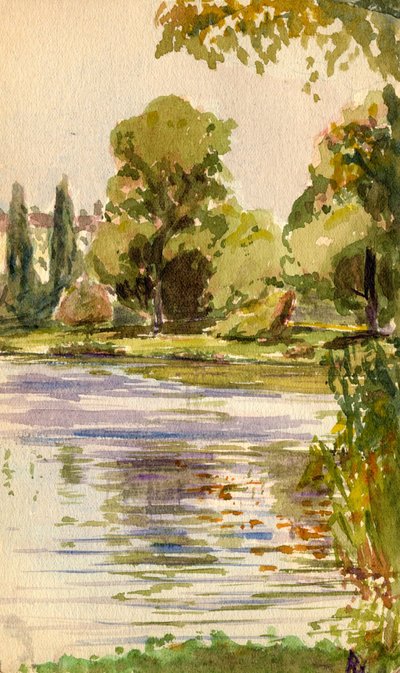During Roger’s final year in high school, he witnessed the publication of his first work, “How the Lion Got His Mane,” a fable he wrote that was displayed in the Keene High School Enterprise. By this time in his life, Roger’s sketchbooks had matured greatly in terms of overall quality and clarity. When not focused on landscapes, his drawings featured mechanical or mundane objects, which were textured and shaded with great detail. Some of his landscapes were labeled, and while most featured sights around Keene, some contained drawings of Surry, suggesting that the Hayward family was still connected in ways to their more northern kin. Roger’s first watercolors appeared about halfway through his 1916-1917 sketchbook and featured a colorful lake setting, but the traditional theme soon moved on to beautiful city scenery and clouds. Near the end of the school year, Roger took a weeklong trip to New York, his first, where among other activities he saw eight theatrical performances, including “Twelfth Night” with E. H. Southern and Julian Marlowe.
Roger graduated from high school in the spring of 1917, mere months after the U.S. declared war on Germany and began active participation in World War I. Rather than wait to be enlisted, Roger volunteered for the Naval Reserve, and ended up spending most of the following summer in a sailor’s uniform on good ship Bumkin Island, an island in the southeast corner of Boston Harbor. Roger was initially designated an apprentice seaman on inactive duty, but was soon shifted to ship’s company, where he spent much of his time making a map of the local barracks. As a result of these duties, Roger gained experience with plain drafting in ink on linen under conditions of changing humidity. It seems a lesson was learned. “After seeing drawings vary in dimension almost 1/8th inch per foot from one day to the next,” he wrote, “it seemed to me that there were other things more important than precision in drawing.”
Roger brought a sketchbook with him during his summer deployment, and most of his summer drawings feature buildings, ships and, as one might imagine after being stationed on an island all summer, most contain elements of water. The summer seems not to have been unpleasant, but Roger ended his short stint in the Naval Reserve as the school year approached. He received news of his acceptance to the Massachusetts Institute of Technology (MIT) in late September and soon after began his studies.

Watercolor painting by Roger Hayward of a pond scene in New England, ca. 1916-1917. More images here

Roger Hayward wearing his Naval uniform, ca. 1917. More images here
